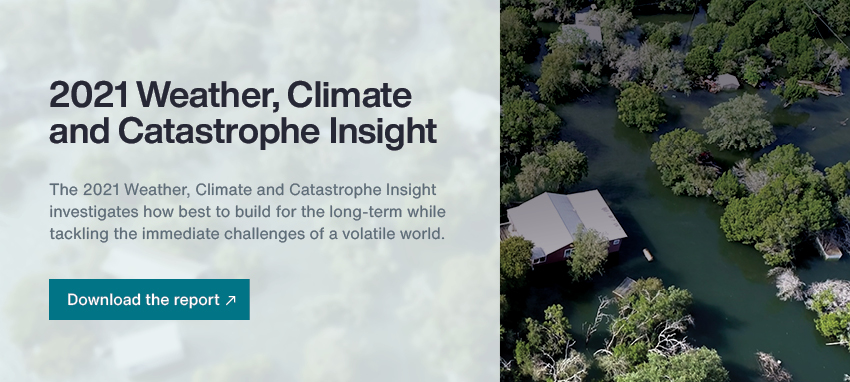Interruptions to supply chains are regular and costly occurrences – demonstrated with the blocking of the Suez Canal, the Texas cold snap and a drought in Taiwan. Against the backdrop of a pandemic, such events are estimated to have created supply chain challenges, costs and losses for over two thirds of the global business community.
Coupled with the risk of disruption caused by catastrophes and the evolving climate, it has never been harder to balance the need for flexible, cost-effective supply chains.

As climate change makes extreme weather more frequent and severe, it raises the probability of events that are more intense than manufacturing facilities are constructed to withstand. Companies and consumers alike are already seeing the impact of climate change on production costs, reduced delivery times and the quality of goods delivered to the end user.


The need for innovation
Supply chains were already fragile as companies sought to drive efficiencies and margins through sourcing of materials, ingredients and components as well as the distribution of their end products. Liquidity strategies based on the use of reduced inventories and ‘just-in-time’ (JIT) fulfilment processes have increased exposure to disruption. Though effective at reducing flow times and costs within production and distribution systems, these inventory and manufacturing workflows are susceptible to supply and demand shocks. When global supply chains are disrupted – as we’ve seen with the pandemic, the Suez blockage and unpredictable weather events as recent examples – JIT production can fail. Leaving companies to pay fines for missing deadlines, empty shelves for consumers and extensive delays for components of larger products (chips for electronic goods, as another recent example) – all of which can have serious repercussions on a retailer’s reputation, cash flow and revenue.
Simultaneously, climate change is evolving so quickly that quantifying risk is increasingly important and insuring risk is increasingly more difficult. Companies are hard-pressed to remain agile in today’s increasingly volatile landscape but need to understand both the current and possible future risk exposure, including the influence of our changing climate. Beyond limiting loss and disruption, visibility into risk exposures has far-reaching implications on a company’s growth. Board Members must be seen as aware of risk exposures and how they’re being handling in answering to shareholders and conducting due diligence around M&A deals. With a data-driven approach to understanding its position, a company is better equipped to proactively mitigate risk and optimize its risk financing strategy.
As companies deal with physical changes and a transition to a more sustainable business, they need to align the impacts of climate change to balance sheet solutions that can reduce volatility. Climate change requires a forward-looking approach and the assessment of the ‘more intangible’ transition risks.


5 ways to strengthen your supply chain resilience
- Assess and align your macro exposures to specific industry sector events including extreme weather conditions, environmental and climate forecasting as well as political unrest to protect the assets from sea-level rises, wildfires, earthquakes etc
- Identify and mitigate a range of reputational issues culminating from supply chains including diversity and inclusion, modern slavery, child or forced labour and human trafficking
- Where there is a concentration of exposure, consider de-risking the supply chain by re-engineering where possible, managing risk and assessing the role of contracts and agreements, as a tool for risk management
- Explore how you can improve existing supply chain processes and procurement operations with insurance, risk management and finance teams
- Discover how you can match insurer capital to current and emerging exposures through improved risk insights across key suppliers and third-parties. This could include captive insurance companies or index-linked, parametric solutions

About the Author

Richard Waterer is the Global Risk Consulting Leader at Aon. He leads a team dedicated to helping clients identify and quantify risk, select and implement strategies around risk transfer, retention and mitigation, and provides post-loss consulting.